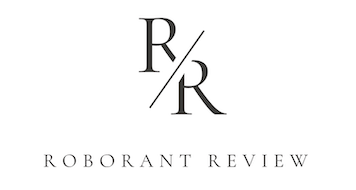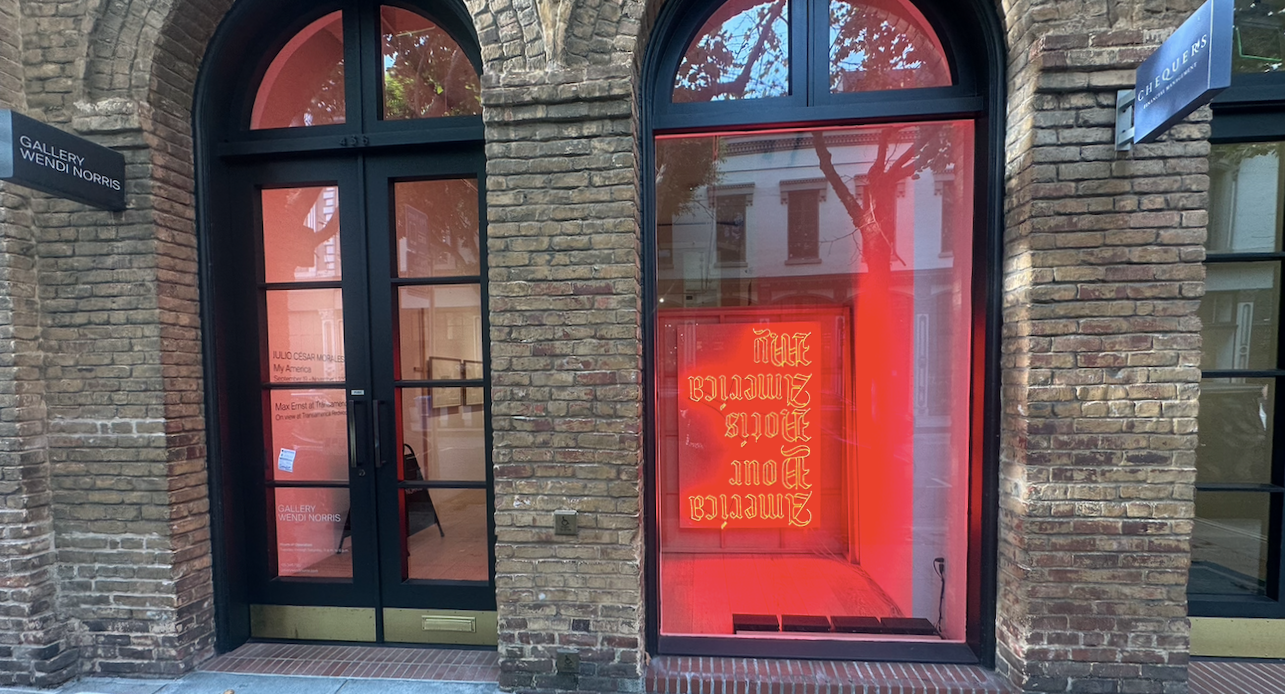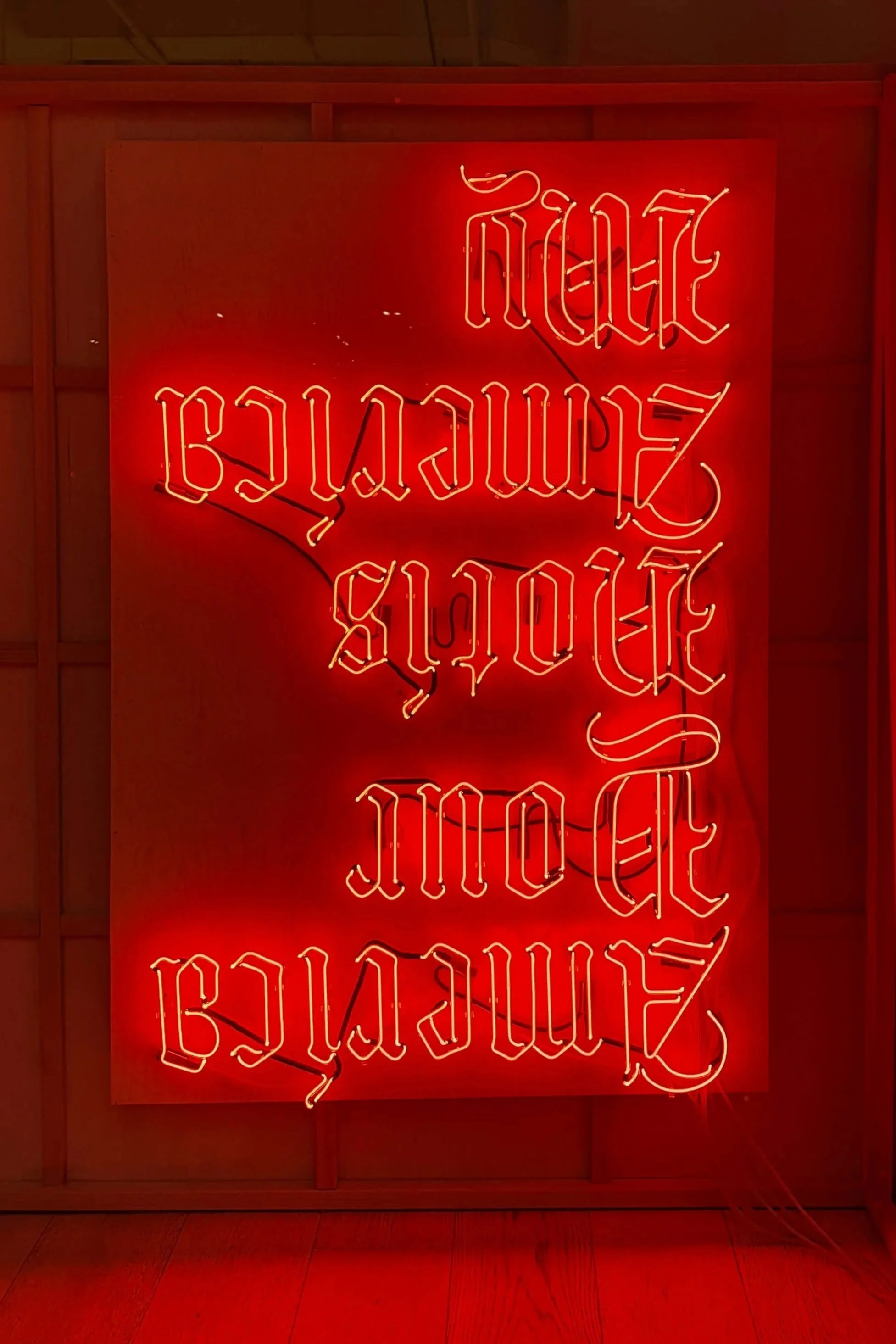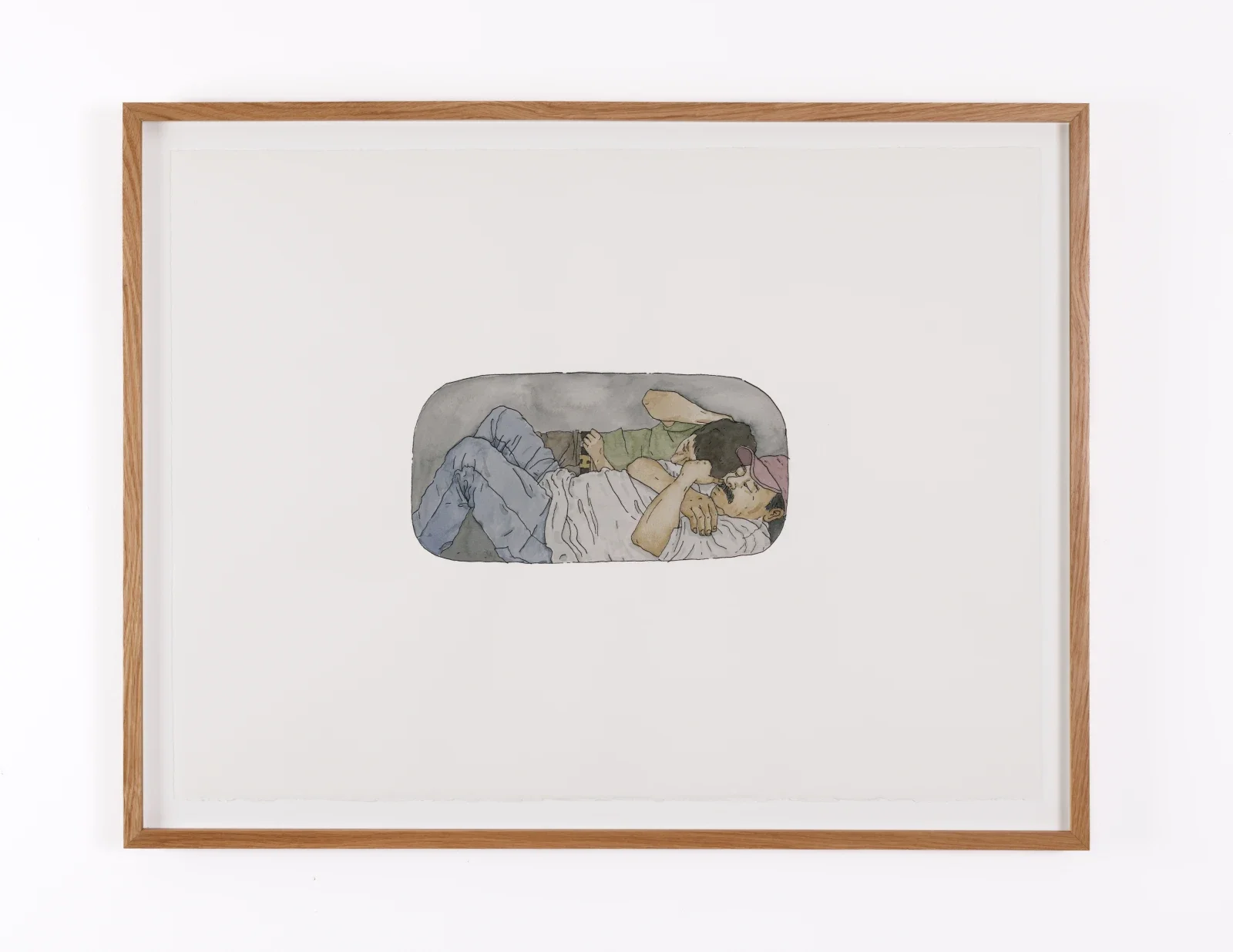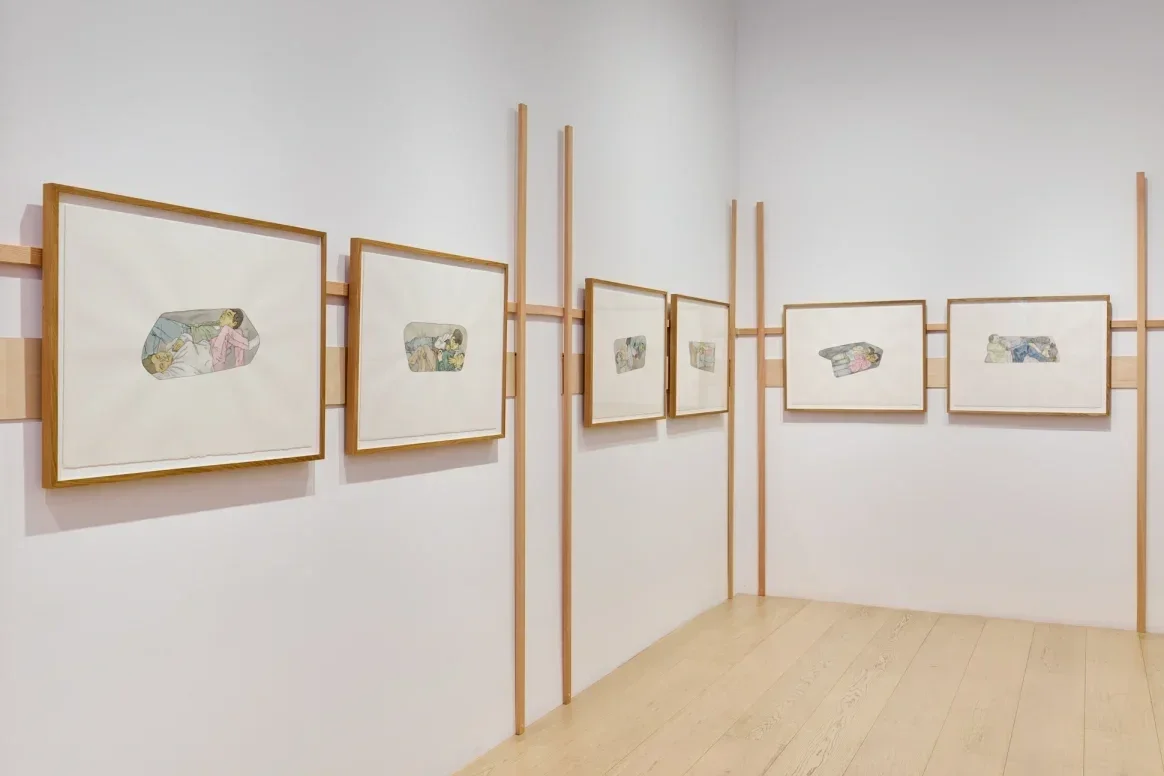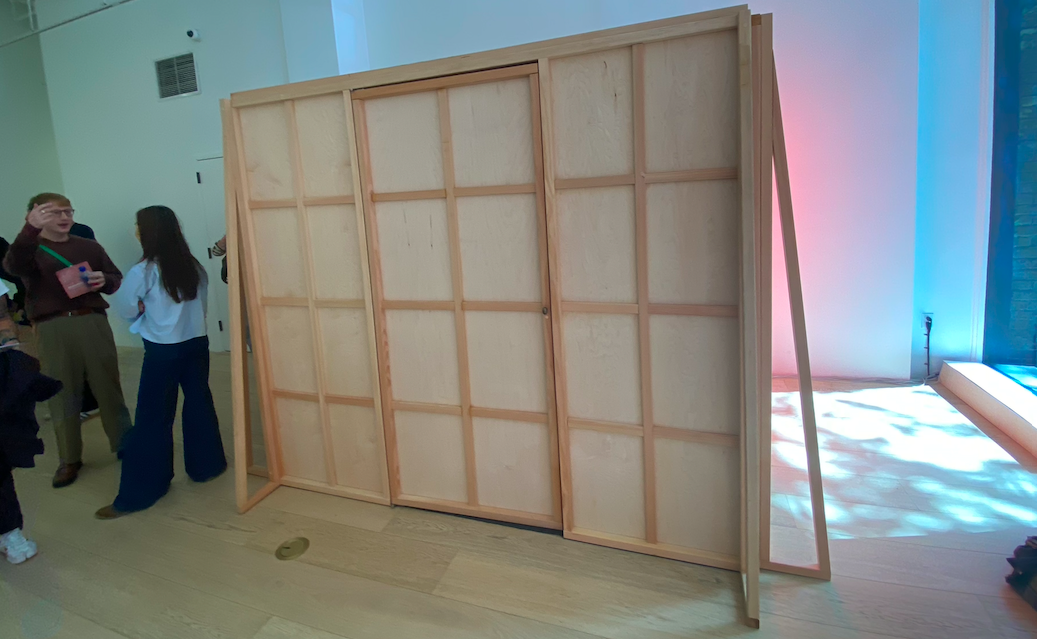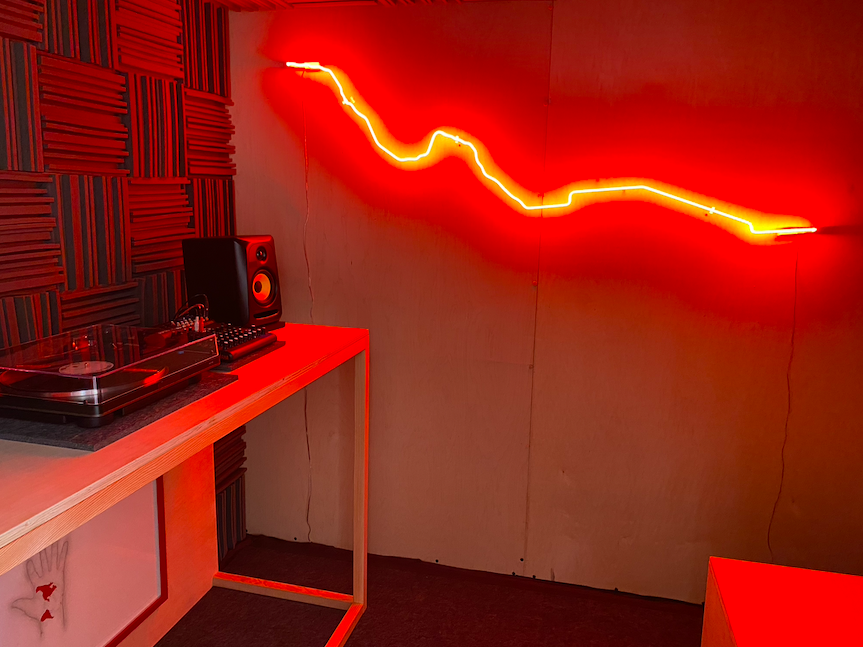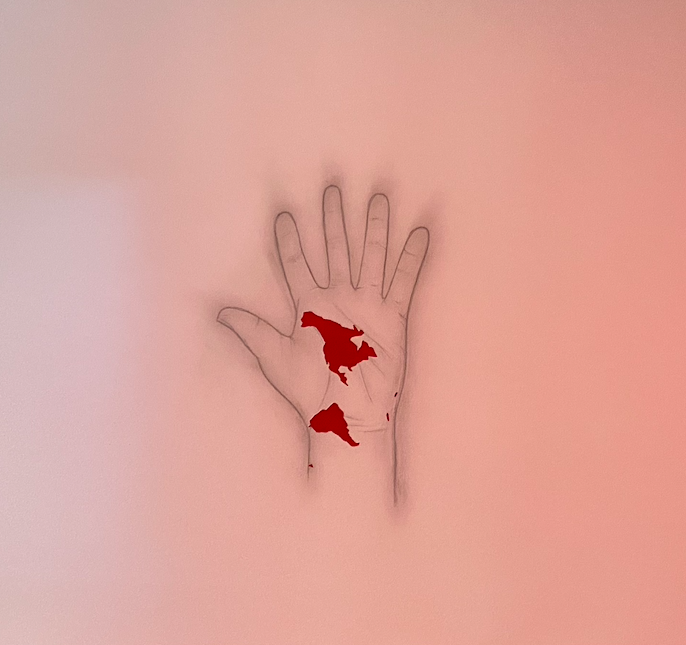Julio Cesar Morales, My America, Gallery Wendi Norris
By Hugh Leeman
Outside Gallery Wendi Norris in San Francisco's compact Jackson Square neighborhood, where gold rush-era buildings back the facades of today's trendy consumer boutiques, a glowing red neon sign beckons attention to a complex world beyond the facade. Crossing the gallery's threshold leaves behind shopping's fads, transporting us into Julio Cesar Morale's My America. The Mexican American artist's exhibition at the gallery runs in complement to OJO, a career survey at the Jan Shrem and Maria Manetti Shrem Museum of Art at UC Davis.
Just inside the gallery, a soft hum from the neon sign's transformer signals one's arrival at an uncanny intersection where creative imagination, inspired by modern scholarship, converges with art history and immigration, as ancient history synchronizes with contemporary agony.
The neon sign’s text, set in an Old English typeface recalling Chicano lowrider culture, [1] reads: “America Your Not is America My.” Seen from the street, its red glow evokes the red-light district where Morales grew up in Tijuana, Mexico. The unusual layout pushes the eye to flow back and forth as if following the bends of a river while searching for meaning. Tijuana itself sits beside the Tijuana River, which originates in Mexico and crosses the border into the U.S.; its currents have left an imprint on Morales’ life and art. During his artist talk, he reflected: “I grew up crossing the border every day until I was 20 years old.” [2] Finding meaning through reordering the phrase into “My America is not your America” underscores the vastly different cultural, economic, and historical realities shaping the Americas.
The exhibit's most powerful works are a series of eight watercolors titled Gemelos, Spanish for "twins." In each piece, two bodies cram into a confined space that the artist describes as portals.[2] The paintings are based on images documenting children smuggled across the Mexico/U.S. border by hiding themselves in the stuffing of car seats.
The Gemelos series' social commentary draws from an ancient past while reflecting on today's most pressing struggles. In ancient Mesoamerica, the Popol Vuh, a Maya origin myth, centers around twins who, throughout their transformational journey, overcome deadly tests of endurance as they pass through portals that allow them to traverse disparate worlds. Along the way, they dress themselves in humble rags of the poor, experience a process of death and resurrection, all before triumphing over malevolent forces through self-sacrifice and magical performances.[3]
The Gemelos works are separated from the wall by small, raw wood beams, a recurring medium the artist uses to reference a common building material that he notes alludes to the act of immigrant labor. [1] The assembled wood structure suggests a fence creating a border between the artworks and the gallery's wall. As viewers, we are capable of seeing the watercolors through the empathic eyes of attempting to understand, yet remain incapable of knowing what it's like to be on the far side of the border fence separating the United States' culture of consumption from the desperation of circumstance. Nevertheless, the exhibit's Gemelos passage through Morale's proposed portals reminds us that, like any historical separation wall, it is not impenetrable, as the expanse of white paper that surrounds the gemelos' isolation functions as a visual wall through which their bodies pass.
The figure's shared space is so confined by the intimacy of their interconnected bodies, suggesting they have returned to the womb, alluding to the potential for rebirth. Incongruously, the dark claustrophobic constraints evoke a coffin-like structure, underscoring the duality of twins and the space they inhabit, characterizing a separation from the mother (land) and family, acting as a death of oneself with the opportunity for a new life on the far side of the wall. Their experience of death and rebirth is bound in a feat of endurance and self-sacrifice, recalling the Maya Hero Twins.
A variation on the theme My America is not your America echoes through the exhibit via music collaboratively created by Morales and Mexico City-based musician and producer, the Mexican Institute of Sound. The music emanates from a makeshift sound booth installation constructed of the same raw lumber as the fence behind the Gemelos. Inside, visitors can listen to music playing on a turntable. “It was designed for two people to enter at a time,” the artist explains, [2] a constraint that mirrors the intimacy and confinement of the Gemelos series.
A neon glass tube hangs inside the sound booth, saturating the room in a red glow, mapping the border between Mexico and the U.S.A., yet like the text at the front of the gallery, the border is upside down, intimately understood when one's world has been upended, the confined room's ambient protest music envelops visitors with a chorus of Your America is not America, My America don't let me down.[4]
Turntable and artwork La Mano Poderosa under the turntable
Tucked beneath the turntable, in a space recalling the cramped dimensions of the Gemelos, we see Morales modernized La Mano Poderosa (The Powerful Hand), a widely produced 19th-century Christian symbol representing divine intervention that protects against malevolent forces, attracts prosperity, and promotes health. The imagery commonly circulated in rural towns in central and northern Mexico before migrating to the Southwest United States.[5] The artist has enlarged the hand's stigmatic wound into the land mass of the Americas. The modern evolution and dynamic symbolism in Morales' art history reference align with celebrated Chicana author Gloria Anzaldua, who wrote in 1987, "The U.S.-Mexican border es una herida abierta (an open wound) where the Third World grates against the first and bleeds. And before a scab forms, it hemorrhages again, the lifeblood of two worlds merging to form a third country—a border culture".[6]
The complexity that forms what Anzaldua termed a third country, border culture, could represent the artist’s family, Morales says, "I have a complicated family where there's coyotes, people who give safe passage to migrants coming across, there's judges, police, many different variations in my family." [2] His family, as influenced by the border culture, is hardly an outlier. Notably, the 'artist's family shares similarities with that of author Francisco Cantu, a former U.S. Border Patrol agent and grandson of a Mexican immigrant,[7] whose book, The Line Becomes a River: Dispatches from the Border, has inspired the artist's neon artworks.
Great art, it has long been said, holds a mirror to society. At Gallery Wendi Norris, Morales unearths a buried mirror reflecting hidden aspects of America's unsettling social landscape. Considering the parallels between his Gemelos series and the legendary Maya Hero Twins' self-sacrifice, journeys through portals, and magical performances, one clearly sees reflections of an ancient world. Yet, today, Morales' Gemelos' magical performance is one of invisibility, the unseen labor of immigrants performing for a culture of consumption. In Julio Cesar Morale's My America, the invisible twins, with one foot in this world and one foot in another, are citizens of a liminal land whose national anthem's chorus reverberates My America is not your America across a divided continent.
Citations:
“Julio César Morales | My America.” Gallery Wendi Norris, gallerywendinorris.com/exhibitions/105-julio-cesar-morales-my-america.
Morales, Julio Cesar. Artist Talk. Gallery Wendi Norris, 18 Sept. 2025. Unpublished recording by the author.
Christenson, Allen J., translator. Popol Vuh: Sacred Book of the Quiché Maya People. University of Oklahoma Press, 2003. Mesoweb, 2007, www.mesoweb.com/publications/Christenson/PopolVuh.pdf
"Mexican Institute of Sound (Ft. Graham Coxon) – My America Is Not Your America." Genius, genius.com/Mexican-institute-of-sound-my-america-is-not-your-america-lyrics.
Smarthistory. "The All Powerful Hand and Private Devotion in Mexico." YouTube, 15 Feb. 2022, www.youtube.com/watch?v=F16_D_B91n8.
"Borderlands = La Frontera : The New Mestiza : Anzaldúa, Gloria, Author : Free Download, Borrow, and Streaming : Internet Archive." Internet Archive, 2012, archive.org/details/borderlandslafro0000anza_k1y9.
Carr, Jane Greenway. "The Line That Rips Through People's Lives." CNN, 27 Apr. 2018, www.cnn.com/2018/03/02/opinions/francisco-cantu-immigration-border-jane-carr-opinion.
